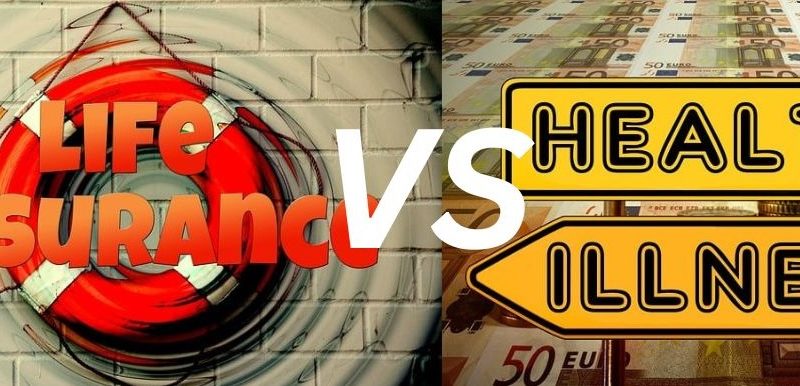Life Insurance vs Health Insurance: Key Differences Explained Simply (2025 Global Guide)
Explore the key differences between life and health insurance in 2025. A simple global guide for smart financial protection choices
In 2025, conversations about financial security go beyond saving money or investing—it’s about protecting your health, your family, and your future. Two major players dominate this landscape: life insurance and health insurance.
Both are essential but in very different ways. Yet, confusion is common:
- “Do I need health insurance if I already have life insurance?”
- “Which should I buy first?”
- “Are global travelers better off with international health or a life policy?”
This guide explains these differences clearly, using real-life examples, expert advice, and global case studies. By the end, you’ll know which insurance to prioritize—or how to combine both for maximum peace of mind.
Life insurance and health insurance are two pillars of modern financial security, each serving unique purposes for individuals and families worldwide.
What is Health Insurance? Explained Simply
Health insurance plays a vital role in reducing the burden of medical costs and ensuring access to treatment. According to the World Health Organization (WHO), strong health financing systems are key to universal healthcare access worldwide. Similarly, data from the OECD shows how insurance coverage trends differ significantly across countries, highlighting the need for global awareness when choosing plans.
For readers new to the basics, Investopedia’s guide on health insurance explains how policies work, while Investopedia’s life insurance overview provides a clear breakdown of types of life policies and who benefits.
In the U.S., government resources like the Centers for Medicare & Medicaid Services (CMS) offer step-by-step help for beginners exploring coverage options. On a global scale, the International Labour Organization (ILO) emphasizes how both life and health insurance form essential pillars of social protection for families and workers.
- Covers Medical Costs: Pays for treatments, prescriptions, and hospital stays if you’re sick or injured.mytribeinsurance+1
- Policyholder Benefits: The insured is the direct beneficiary of the coverage.
- Renewable Contracts: Policies are typically renewed annually, with premiums recalculated as needed.
Think of health insurance as your shield against medical costs. It covers expenses when you:
- Visit a doctor for regular check-ups
- Get hospitalized after an accident
- Require surgeries or specialized treatments
- Need prescription medication
Key Features:
- Coverage: Hospital bills, tests, emergency services, and sometimes dental/vision.
- Beneficiary: You (the policyholder) use the benefits directly.
- Duration: Usually renewed annually with updated premiums.
- Flexibility: Options for individuals, families, or global travelers.
For expats and frequent travellers, international health insurance is growing fast in 2025. Providers like Allianz Global Assistance and GeoBlue offer global hospital access, perfect for digital nomads or professionals working abroad.
If you’re a beginner in choosing policies, check this full guide: Best Health Insurance Plans for Beginners: Global 2025 Guide.
What is Life Insurance? Breaking It Down
- Financial Security for Others: Pays a lump sum to your family or beneficiaries when you die or are diagnosed with a critical illness.
- Long-Term Contracts: Often last several years or for the insured’s lifetime.
- Premiums: Usually fixed and tend to be lower when purchased young.
Life insurance is less about today’s medical costs and more about future financial security. It pays a lump sum (death benefit) to your family or chosen beneficiaries if you:
- Pass away
- Are diagnosed with a critical illness (depending on the policy)
Key Features:
- Purpose: Protects loved ones financially.
- Beneficiary: Your family (spouse, children, dependents).
- Duration: Long-term—can span decades or even a lifetime.
- Premiums: Generally cheaper when purchased young and fixed over time.
💡 Example: A 30-year-old buying a $500,000 life policy will pay far lower premiums than a 50-year-old buying the same coverage.
Life insurance isn’t about you—it’s about the legacy and stability you leave behind.
Life Insurance vs Health Insurance: Key Differences Table
| Feature | Health Insurance | Life Insurance |
|---|---|---|
| Purpose | Pays medical bills (hospital, treatment) | Pays lump sum after death or illness |
| Beneficiary | Policyholder (you) | Family / designated beneficiaries |
| Renewal | Monthly or yearly | Multi-year or lifetime contracts |
| Coverage Type | Acute, chronic, preventive, emergency | Death, disability, critical illness |
| Financial Role | Reduces out-of-pocket medical expenses | Provides financial security to loved ones |
| Tax Implications | Varies by country | May be tax-free in many regions |
For deeper insights into how insurance works globally, you can also check: How to Choose the Best Car Insurance Plan for Global Travelers.
Learn more: Life Insurance vs Health Insurance: Which Comes First? and Key Differences Between Life Insurance and Health Insurance.
Case Studies Around the World
1. USA Family with Young Kids
A couple in Texas chose life insurance first. Their reasoning? If either parent passed unexpectedly, the payout would cover the mortgage, kids’ college funds, and living expenses. They later added health insurance through an employer plan.
2. Indian IT Professional in Bangalore
Ravi, 27, faced rising medical costs and chose health insurance first. His priority was avoiding financial ruin from hospital bills after seeing relatives spend their savings on surgery. Once his income grew, he added a small life insurance plan.
3. German Expert in Singapore
Lisa, 35, relocated for work. She prioritized international health insurance from Allianz Global because of frequent travel in Asia. Later, she invested in life insurance back in Germany for long-term family protection.
These stories highlight one truth: The right choice depends on personal stage, location, and goals.
When Should You Prioritize Health Insurance?
Health insurance is often the first line of financial defense because medical costs can spiral out of control, especially in countries where healthcare is largely privatized. For example, in the United States, a single hospital stay can run into tens of thousands of dollars, while in Japan advanced treatments like cancer care are extremely costly without insurance.
If you already have existing health conditions—such as diabetes, heart disease, or even a family history of chronic illness—choosing health insurance first ensures you won’t be stuck paying overwhelming bills out of pocket. Insurance doesn’t just protect your wallet; it makes regular checkups, preventive care, and emergency services more affordable and accessible.
Another situation where health insurance should come first is if you are a frequent traveler or expat. Hospitalization costs abroad can be financially devastating, and some countries require proof of insurance before granting visas or work permits. A strong international health plan ensures you’re covered no matter where life takes you, from an emergency surgery in Singapore to routine care in Germany.
In short, health insurance is your day-to-day safety net, designed to keep you healthy and financially stable in the present.
When Should You Prioritize Life Insurance?
Life insurance, on the other hand, is about long-term financial security for your loved ones. If you have dependents—such as a spouse, children, or elderly parents—this type of policy ensures that they won’t struggle financially if you pass away unexpectedly. It’s a safety cushion that replaces lost income, helps pay bills, and even covers education expenses for kids.
If you’re young and healthy, buying life insurance early is often a smart move. Premiums are significantly lower when you’re in your 20s or 30s, and locking in a policy now can protect you from steep costs later if your health changes. Think of it as securing peace of mind at a discount.
Another common reason to prioritize life insurance is if you’ve taken on large financial commitments, such as a mortgage. In the unfortunate event of your passing, a good policy ensures your family won’t be burdened with paying off the home loan or risk losing their house.
Where health insurance looks after your current well-being, life insurance ensures your family’s future stability.
Together, both types of insurance complement each other. Health insurance protects you while you’re alive, and life insurance protects those you love after you’re gone.
For beginners, here’s a must-read: Insurance Policy Guide 2025: How to Choose Right Coverage.
How They Work Together: The Perfect Balance
Health insurance = immediate protection.
Life insurance = future security.
A smart financial plan often includes both. Example:
- Health insurance handles your hospital bills today.
- Life insurance secures your family’s financial future tomorrow.
This combo prevents families from falling into debt due to either medical bills or loss of income.
The Cost Factor: Premiums, Deductibles, and Affordability
One common myth is that both insurances are too expensive. But in reality:
- Health insurance premiums depend on age, country, and plan type. High-deductible plans cost less monthly but more during emergencies.
- Life insurance premiums are lowest if purchased young and healthy.
Average 2025 Premiums Globally (illustrative):
- Health insurance: $100–$400 per month for individuals.
- Life insurance: $25–$100 per month for young adults (term policies).
Global Trends in Insurance 2025
- AI-driven policies: Insurers now use AI to customize plans. See: Top 7 AI Tools in 2025 That Can Save You Time and Money.
- Hybrid coverage: Some insurers now bundle life and health features.
- Digital claims: Filing and approving claims is faster through apps.
- Focus on mental health: Health insurance now includes counseling in many countries.
Using Smart Digital Tools to Choose Better
Modern platforms let you:
- Compare multiple insurers instantly.
- Read real-world reviews of claim experiences.
- Use calculators to estimate how much coverage you actually need.
For online safety while shopping insurance policies, also read: Step-by-Step Guide to Protect Your Online Privacy in 2025.
For deeper learning:
- iPhone 15 vs Samsung S24: 2025 Flagship Showdown (for gadget lovers exploring financial decisions).
- Best Health Insurance Plans for Beginners: Global 2025 Guide.
- Top 7 AI Tools in 2025 That Can Save You Time and Money.
Choosing Your Financial Shield in 2025
Life insurance and health insurance are not competitors—they’re complements.
- Health insurance is your safety net today, saving you from medical debt.
- Life insurance is your safety net tomorrow, protecting your loved ones financially.
Which comes first? It depends on your life stage:
- Young professionals often start with health insurance.
- Young families often begin with life insurance.
- Smart planners eventually combine both.
The key is to compare carefully, read the fine print, and choose what protects you best. In 2025, with AI tools, global providers, and online resources, there’s no excuse to stay unprotected.
💬 What about you? Do you prioritize life insurance or health insurance first? Share your experiences and tips in the comments below—we’d love to hear from you!



